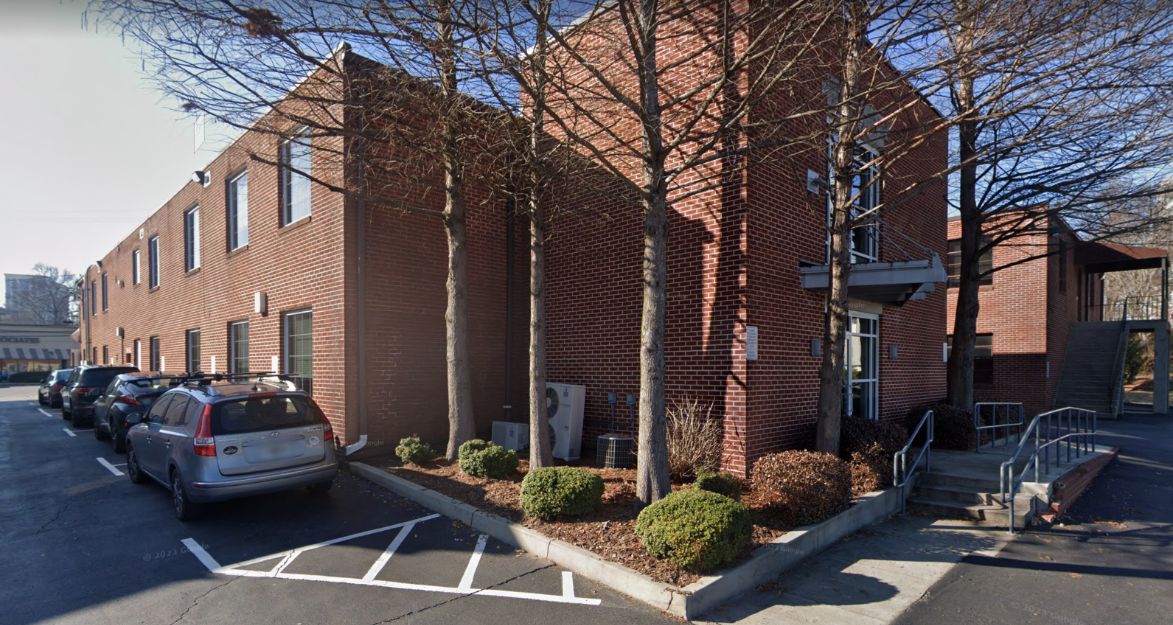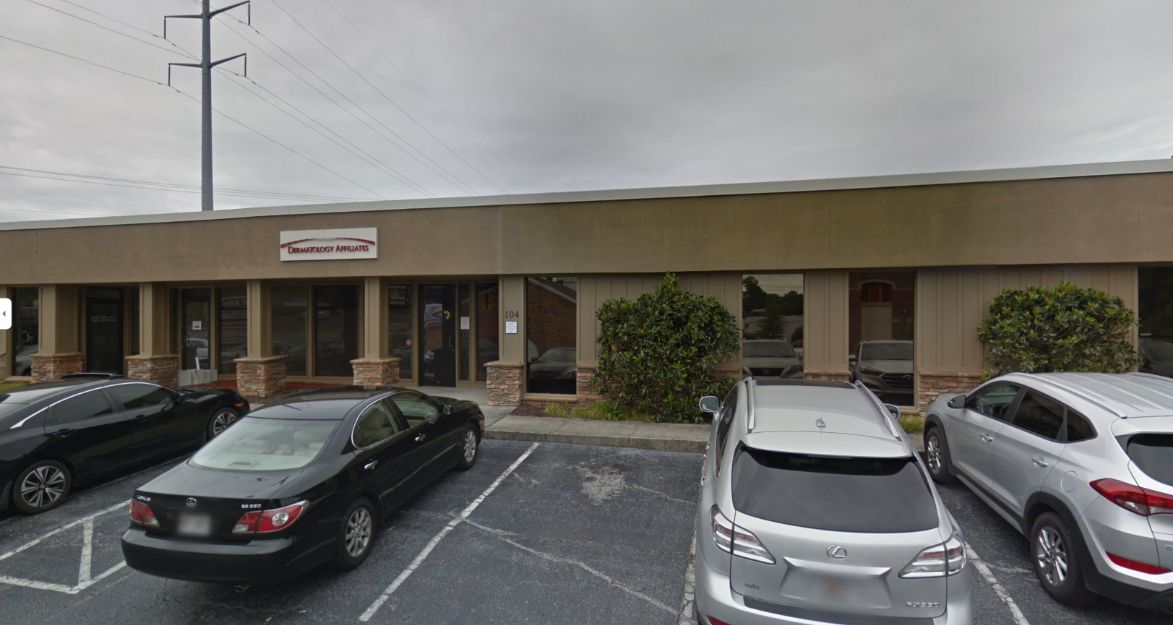Identifying Early Signs of Shingles
 Shingles can strike when you least expect it, often bringing with it a host of uncomfortable symptoms. At Dermatology Affiliates, we understand the urgency of recognizing the early signs, such as unusual skin sensations and nerve pain, before the characteristic rash even appears. This article will guide you through the initial symptoms and the progression to blisters, emphasizing the importance of early detection to prevent complications like nerve paralysis. By reading on, you'll learn when to seek medical advice and the effective medications available to manage this condition. Our goal is to empower you with knowledge, so you can act swiftly at the first hint of shingles.
Shingles can strike when you least expect it, often bringing with it a host of uncomfortable symptoms. At Dermatology Affiliates, we understand the urgency of recognizing the early signs, such as unusual skin sensations and nerve pain, before the characteristic rash even appears. This article will guide you through the initial symptoms and the progression to blisters, emphasizing the importance of early detection to prevent complications like nerve paralysis. By reading on, you'll learn when to seek medical advice and the effective medications available to manage this condition. Our goal is to empower you with knowledge, so you can act swiftly at the first hint of shingles.
Understanding Shingles and Its Causes
Shingles, a condition marked by a painful rash, arises when the varicella-zoster virus, which lies dormant in those who've had chickenpox, reactivates. I'll explain how a compromised immune system can trigger this reactivation, leading to symptoms like itching, blistering, and potentially severe neuralgia. Understanding the risk factors for this virus's resurgence is crucial for maintaining health and preventing its painful manifestations.
What Is Shingles and How Does It Develop
Shingles is an infection that stems from the reactivation of the varicella-zoster virus, the same virus responsible for chickenpox. It typically develops when the immune system is weakened, which can be due to stress, aging, or immunodeficiency conditions. The initial signs and symptoms often include pain and tingling, followed by a blistering rash that can be intensely uncomfortable. As a dermatologist, I've observed that early detection and treatment are key to managing the herpes zoster infection effectively and mitigating its impact on one's quality of life.
The Role of the Varicella-Zoster Virus
The varicella-zoster virus, a dormant entity in individuals who have previously contracted chickenpox, plays a pivotal role in the development of shingles. In my practice, I've seen how a weakened immune system can fail to keep this virus in check, leading to its reactivation and the onset of shingles. Patients often seek relief from the acute discomfort and the risk of postherpetic neuralgia, a chronic pain condition that can follow a shingles outbreak. To mitigate these risks, the zoster vaccine is recommended, especially for older adults, as a preventive measure. It's also worth noting that the varicella vaccine, administered to prevent chickenpox, indirectly reduces the chances of shingles by lowering the initial exposure to the virus.
Risk Factors for Reactivation of the Virus
In my professional experience, certain factors significantly elevate the risk of the varicella-zoster virus reactivating and leading to the early signs of shingles. Individuals who have a history of chickenpox are at risk, as the virus remains in a dormant state within their body. As we age, or if our immune system becomes compromised due to illness or medical treatments, the likelihood of this virus reawakening increases. It's imperative to recognize symptoms such as skin sensitivity or fluid-filled blisters as potential indicators of shingles. The Centers for Disease Control and Prevention also highlight stress and certain medications as contributing factors. Being vigilant about these risk elements can aid in early detection and prompt management of the condition.
Early Skin Sensations to Recognize
Recognizing the early signs of shingles can significantly reduce the risk of complications like encephalitis and persistent inflammation. Tingling and burning sensations on the skin, often without a visible rash, are key indicators. Additionally, unusual itching and heightened sensitivity to touch in specific areas may precede the more noticeable symptoms such as headache and fever. These early skin sensations are vital to identify, as they can lead to timely diagnosis and treatment.
Tingling and Burning Feelings on the Skin
In my practice, I've noticed that a tingling or burning sensation on the skin can be a harbinger of shingles, particularly in areas where the varicella-zoster virus may reactivate. This discomfort, often concentrated around the trunk or eye, can precede the appearance of the rash by days. Patients with compromised immunity, including those with HIV, should be particularly vigilant about these sensations. While there is no cure for shingles, the vaccine can bolster immunity and reduce the risk of the virus's resurgence, offering a preventive strategy for those at higher risk.
Unusual Itching Without a Visible Rash
In my practice, I've encountered patients who report an unusual itching sensation, one that's not accompanied by a visible rash. This symptom can be perplexing, as it may be mistaken for an allergy or dermatitis. However, in the context of shingles, it's a critical early sign, particularly when other risk factors such as stress, disease, or even pregnancy are present. It's essential to differentiate this itching from other skin conditions, as it can guide us toward an early diagnosis of shingles, allowing for prompt and effective treatment.
Sensitivity to Touch in Specific Areas
In my dermatology practice, I've observed that heightened sensitivity to touch in specific areas, particularly near the brain or ear, can be a subtle yet significant early sign of shingles. Patients may describe this as a discomfort or pain when clothing or even a breeze touches their skin. This symptom is especially pertinent in patients who are undergoing chemotherapy, as their immune system is often weakened, making them more susceptible to the reactivation of the varicella-zoster virus. It's imperative for these individuals to seek medical advice promptly, as early intervention can prevent the progression of shingles and its associated complications.
Identifying the Pre-Rash Symptoms
In my dermatological practice, I've learned that shingles often heralds its arrival with subtle, non-rash symptoms. Localized pain, a common precursor, can target the torso, signaling potential nerve injury before any visible signs appear. Patients may also experience flu-like symptoms without the fever, alongside fatigue and a general sense of malaise. These indicators are critical for early therapy and can help prevent the progression to the more painful, blistering rash that characterizes shingles.
Localized Pain That Precedes the Rash
In my dermatology practice, I often encounter patients who describe a localized pain that precedes the characteristic rash of shingles. This pain, which can be quite severe, is a telltale sign of the herpes zoster virus reactivating. The American Academy of Dermatology recognizes this symptom as a key diagnostic clue, particularly when it presents in areas where the rash will later emerge. While there is no cure for shingles, understanding and identifying this early symptom can lead to prompt treatment, reducing the risk of complications such as herpes zoster ophthalmicus. Over-the-counter pain relievers like paracetamol can offer temporary relief, but it's essential to consult a healthcare professional for comprehensive management.
| Early Symptom | Associated Condition | Recommended Action |
| Localized Pain | Herpes Zoster Reactivation | Consult Healthcare Professional |
| Herpes Zoster Ophthalmicus Risk | Potential Eye Complication | Seek Immediate Medical Attention |
| Use of Paracetamol | Temporary Pain Relief | Follow Up with Dermatologist |
Flu-Like Symptoms Without a Fever
In my dermatology practice, I've observed patients presenting with flu-like symptoms such as chills and malaise, yet without the accompanying fever that typically signals an infection. These symptoms can be perplexing, but they are often indicative of the varicella-zoster virus affecting the nervous system before the characteristic shingles rash appears. For individuals with compromised immune systems, such as those with type 2 diabetes or undergoing bone marrow suppression therapy, these signs should prompt an immediate consultation. A timely dose of antiviral medication may be crucial in mitigating the severity of the outbreak:
- Notice unusual chills and malaise without fever.
- Recognize these signs as potential indicators of shingles, especially in immunocompromised individuals.
- Seek medical advice promptly to assess the need for antiviral treatment.
Fatigue and General Malaise
In my dermatological practice, I often encounter patients who report a pervasive sense of fatigue and general malaise as early indicators of shingles. These symptoms, while seemingly nonspecific, can be significant risk factors for the development of the condition, particularly when they persist without an apparent cause. As a physician, I emphasize the importance of skin care and monitoring any unusual changes, including persistent tiredness and discomfort, which could precede the visual signs of a shingles outbreak. Prompt consultation can lead to early intervention, potentially involving an antibiotic if a secondary wound infection is a concern, and can significantly alter the course of the virus's impact on the body.
Examples of Shingles
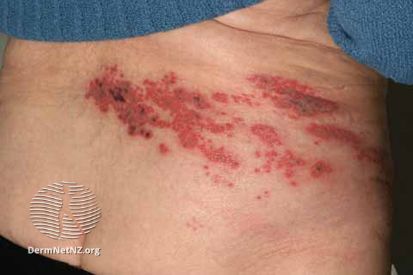
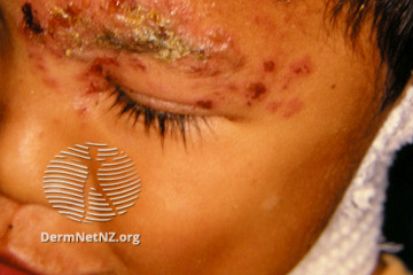
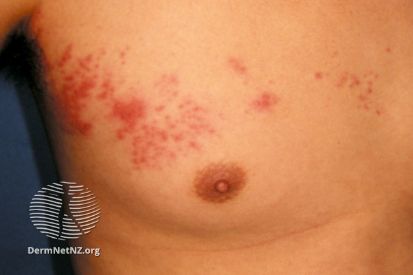
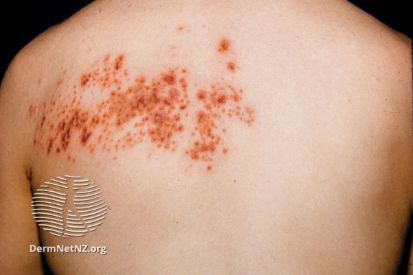
The Appearance of the Initial Shingles Rash
As we delve into the initial presentation of a shingles rash, it's essential to recognize its distinct characteristics. In my practice, I've reviewed cases where the rash typically emerges in specific locations, often wrapping around one side of the torso or face. Distinguishing this rash from other skin conditions is critical and usually requires a thorough physical examination. We'll explore the early rash traits, common sites of development, and how to differentiate shingles from other dermatological issues, using national guidelines and recommended lotions for symptom management.
Characteristics of Early Shingles Rash
In my dermatology practice, I've observed that the initial shingles rash often presents as a cluster of fluid-filled blisters, which may be preceded by a red, inflamed base. Patients with conditions like multiple sclerosis or those experiencing intense stress syndromes may notice these symptoms exacerbate after periods of poor sleep or heightened fatigue. It's imperative for individuals to consult their health care provider if they observe such changes, particularly around the torso or face, as these are common sites for the rash to appear. The involvement of bone or nerve pain in the affected area can also be a distinguishing feature of this viral outbreak, underscoring the need for prompt medical attention and care.
Common Locations for Rash Development
In my dermatological practice, I've noted that the initial shingles rash commonly develops on one side of the torso or face, following a nerve pathway, which can be a clear sign of peripheral neuropathy. Patients often recount a history of pain or tingling in these areas before the rash's appearance. As we age, the risk of such viral reactivations increases, and a thorough medical history is vital for an accurate diagnosis. The National Institute of Neurological Disorders and Stroke provides guidelines that emphasize the importance of early treatment with antivirals like famciclovir to mitigate symptoms and prevent complications. It's my role to ensure patients recognize these patterns and seek medical intervention promptly to manage their condition effectively.
Distinguishing Shingles Rash From Other Skin Conditions
In my dermatology practice, distinguishing a shingles rash from other skin conditions is a critical diagnostic step, particularly for patients undergoing lung cancer treatment or those with compromised immune systems. The rash's unique pattern along a dermatome – a specific area of skin that nerves from the spinal cord innervate – is a distinguishing feature. The Advisory Committee on Immunization Practices recommends that individuals, especially those with weakened immune systems, receive the shingles vaccine to prevent this painful condition. When a shingles rash is suspected, I advise the application of calamine lotion to soothe itching and promote comfort while awaiting confirmation of the diagnosis:
- Examine the rash for a dermatome pattern, which is indicative of shingles.
- Consult the Advisory Committee on Immunization Practices guidelines for vaccine recommendations.
- Apply calamine lotion to alleviate discomfort and itching associated with the rash.
Progression From Rash to Blisters
As we delve deeper into the early signs of shingles, the progression from an initial rash to the formation of fluid-filled blisters is a critical phase. These blisters undergo changes over time, evolving in appearance before eventually leading to scabbing and the healing process. In my practice, I emphasize the importance of pain management and primary care during this stage. Research indicates that the central nervous system plays a role in the discomfort experienced, and some patients may report associated nausea. The following sections will explore these developments in detail, offering insights into the timeline and care strategies for those affected.
Formation of Fluid-Filled Blisters
In my dermatology practice, I've seen the transition from an initial rash to the formation of fluid-filled blisters as a defining moment in the progression of shingles. These blisters, typically concentrated around the neck or torso, can cause significant discomfort, prompting patients to seek health care. I often recommend ibuprofen, a non-steroidal anti-inflammatory drug, to alleviate the pain associated with these blisters. It's crucial for patients to understand that while this medicine can offer relief, it does not replace the need for antiviral medications, which are the cornerstone of shingles treatment.
Changes in Blister Appearance Over Time
In my dermatology practice, I've observed that the blisters characteristic of shingles evolve significantly over time. Initially, these blisters appear as clear, fluid-filled vesicles on a red base, often causing weakness and discomfort in the affected area. Over the course of several days, the blisters can become cloudy and may exhibit signs of infection, particularly in patients with underlying conditions such as colitis or compromised cranial nerves. The Mayo Clinic advises that any stomach pain or unusual changes in the blisters should prompt a consultation, as these can be signs of complications requiring medical intervention.
Scabbing and Healing Process
During the healing phase of shingles, the blisters on the skin begin to dry out and form scabs, a process that can be particularly noticeable when it occurs near sensitive areas like the facial nerve or the abdomen. As a dermatologist, I've seen how the use of an attenuated vaccine can prevent the occurrence of shingles and its side effects in many patients across the United States. It's essential to monitor the scabbing process, as improper care can lead to scarring or secondary infection, complicating the recovery journey:
- Observe the drying of blisters as they transition into scabs, especially around the facial nerve or abdomen.
- Consider the attenuated vaccine as a preventive measure against shingles and its side effects.
- Seek professional advice to ensure proper care during the scabbing phase to avoid complications.
When to Consult a Healthcare Professional
Recognizing the early signs of shingles is pivotal for prompt treatment and can significantly influence the course of the illness. Certain symptoms, such as intense headaches that might be mistaken for migraines, or changes in skin sensation over areas where dressings or injections are administered, should prompt immediate medical consultation. In my practice, I stress the importance of discussing any new or worsening symptoms with your doctor, especially if you experience muscle weakness or are undergoing immunosuppression therapy. These discussions can lead to early diagnosis and more effective management of the condition.
Importance of Early Diagnosis
Securing an early diagnosis of shingles can be a decisive factor in preventing the escalation of symptoms and reducing the risk of long-term complications. In my practice, I've seen how early intervention, guided by the Food and Drug Administration-approved antiviral treatments, can protect tissue from the virus's damaging effects. Patients who are prescribed medications like prednisone for other conditions should be particularly vigilant, as their immune response may be altered, increasing susceptibility to the virus. The National Institute of Allergy and Infectious Diseases emphasizes the importance of recognizing early signs to avoid the potential for the virus to spread and cause further systemic issues, including poison to the body's systems.
| Early Action | Benefit |
| Early Diagnosis of Shingles | Prevents symptom escalation and long-term complications |
| Use of FDA-Approved Antivirals | Protects tissue and mitigates virus damage |
| Monitoring for Immunosuppressed Patients | Reduces risk of systemic issues and virus spread |
Signs That Require Immediate Medical Attention
In my professional capacity, I've seen that certain signs necessitate immediate medical attention to address early shingles symptoms effectively. If you notice a rash that rapidly deteriorates or spreads to sensitive areas like the mouth, or if you experience systemic symptoms such as fever or fatigue that could indicate the virus is affecting multiple cells and organs, it's critical to seek care promptly. These early stage shingles rash symptoms, particularly when accompanied by severe pain or neurological signs, can signal a more serious progression of the condition and require swift intervention to prevent complications.
Discussing Symptoms With Your Doctor
In my practice, I encourage patients to promptly discuss any pre shingles symptoms or shingles signs and symptoms early with their doctor. Recognizing shingles symptoms before rash, such as early stage early shingles on face or unusual sensations, is crucial for timely intervention. Early onset shingles can be subtle, so a detailed conversation about your health history and current symptoms can lead to early detection and more effective treatment options.
Treatment Options for Early Shingles Symptoms
Upon identifying early shingles rash symptoms, timely intervention is key. Antiviral medications offer significant benefits in mitigating the virus's impact, especially when initiated promptly. I'll discuss effective pain management strategies and home care remedies that provide relief from discomfort. For those observing early stage shingles images or symptoms, such as early stage shingles on leg, it's imperative to schedule an appointment with a healthcare provider to explore these treatment options.
Antiviral Medications and Their Benefits
In my practice, I've seen antiviral medications play a transformative role in managing early shingles symptoms. These drugs, such as acyclovir, valacyclovir, and famciclovir, are most effective when administered within 72 hours of rash onset, significantly reducing the duration and severity of the outbreak. Patients often report less pain and a quicker return to their daily activities, underscoring the benefits of early detection and prompt treatment.
Pain Management Strategies
In managing the discomfort associated with early shingles symptoms, I've found that a combination of prescribed medications and home care strategies can be highly effective. For instance, cool compresses applied to the affected area can provide immediate relief, while over-the-counter analgesics like ibuprofen help reduce inflammation and pain. It's essential to follow a pain management plan tailored to your specific needs, which may include topical creams containing capsaicin or lidocaine for localized symptom relief:
- Apply cool compresses to soothe inflamed skin.
- Use over-the-counter analgesics to alleviate pain and reduce inflammation.
- Consider topical creams with capsaicin or lidocaine for targeted relief.
Home Care Remedies to Alleviate Discomfort
In my dermatology practice, I advise patients on effective home care remedies to alleviate the discomfort associated with early shingles symptoms. A soothing oatmeal bath can provide significant relief from itching and irritation, while maintaining a calm and stress-free environment can help manage the overall discomfort. It's essential to keep the rash clean and dry to prevent infection, and wearing loose-fitting clothing can reduce irritation from fabric friction on sensitive skin:
- Take an oatmeal bath to soothe itching and irritation.
- Maintain a calm environment to help manage discomfort.
- Keep the rash area clean and dry to prevent infection.
- Wear loose-fitting clothing to minimize irritation from fabric contact.
Potential Complications From Delayed Treatment
Addressing shingles promptly is vital to avoid severe complications. Postherpetic neuralgia and chronic pain can persist long after the rash heals, significantly impacting quality of life. Vision loss is a serious risk with ophthalmic shingles, while untreated blisters can lead to skin infections. In my practice, I emphasize the importance of early treatment to mitigate these risks, ensuring patients understand the potential consequences of delay.
Postherpetic Neuralgia and Chronic Pain
In my experience, postherpetic neuralgia is a common yet severe complication that can arise from delayed treatment of shingles. This chronic pain condition persists even after the rash and blisters have healed, often leading to prolonged discomfort and sensitivity in the affected areas. I've seen patients struggle with this debilitating pain, which can last for months or even years, emphasizing the critical nature of recognizing and addressing shingles symptoms early to prevent such long-term consequences.
Vision Loss From Ophthalmic Shingles
In my dermatological practice, I've witnessed the grave consequence of vision loss due to ophthalmic shingles, a severe complication that underscores the urgency of early shingles detection and treatment. This specific manifestation of the varicella-zoster virus affects the eye and can lead to irreversible harm if not addressed swiftly. Patients presenting with shingles symptoms near the eye should seek immediate medical care to prevent the virus from inflicting permanent damage to their vision.
Skin Infections Due to Blistering
In my dermatology practice, I've seen how delayed treatment of shingles can lead to skin infections, a complication that arises from the blistering characteristic of the condition. These infections occur when bacteria enter through the open sores of the blisters, potentially leading to increased pain, redness, and swelling. It's imperative for patients to recognize the early signs of shingles and seek medical attention promptly, as timely antiviral therapy and proper wound care can significantly reduce the risk of such infections and accelerate the healing process.
Frequently Asked Questions
Shingles, a reactivation of the varicella-zoster virus, often emerges when the immune system weakens due to stress, aging, or immunosuppression.
Early shingles symptoms often include tingling, itching, or pain in a localized area before any rash appears.
Before a shingles rash develops, early symptoms often include tingling, itching, or pain in a localized area, and sometimes flu-like symptoms without a fever.
The initial shingles rash typically presents as a painful, red patch, often followed by fluid-filled blisters that crust over.
Seek medical advice for shingles if you experience early symptoms like tingling or localized pain, especially if you're over 50 or have a weakened immune system.
Conclusion
Recognizing the early signs of shingles, such as tingling, itching, and localized pain, is critical for prompt treatment and can prevent the condition from escalating into more severe complications. Early intervention with antiviral medications can significantly reduce the duration and intensity of the outbreak, improving patient outcomes. Patients should be vigilant and consult a healthcare professional at the onset of symptoms to mitigate the risk of long-term issues like postherpetic neuralgia. Ultimately, awareness and timely action are paramount in managing shingles effectively and preserving quality of life.
Featured Products
Check your local office for current stock!
Check your local office for current stock!


